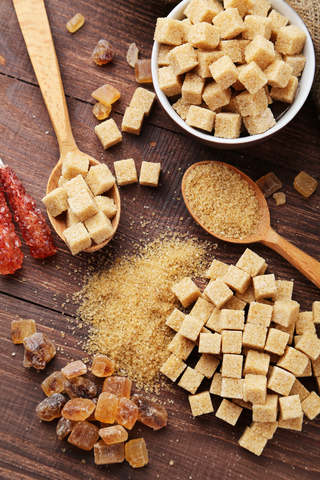A Brief Guide to Natural Sweeteners
Most of us consume sweeteners every day — whether in our morning coffee, as a dessert or as ingredients in food products we love. New natural sweeteners — meaning they come from plant sources versus being synthetically produced — are cropping up on supermarket shelves, but many of us don’t know how to incorporate them or how they affect our health. It’s easy to believe that something “natural” is healthy, but when it comes to sweeteners, too much of even a natural thing can be unhealthy. Added sugars and sweeteners represent about 13 percent of Americans’ daily caloric intakes, and this excess is linked to increased body weight and chronic diseases. In general, you should try to limit your overall intake: The American Heart Association recommends no more than 100 calories per day for women and no more than 150 calories per day for men from added sugars. When you do add some sweetness, consider sources that provide a little more nutritional bang for the buck. Read on to learn more about the pros and cons of 5 different types of natural sweeteners.
Agave syrup (or agave nectar) comes from the same plant that is used to make tequila. It’s sweeter than sugar and has a lower glycemic index, which means that you can use less of it and the impact on your blood sugar will be more moderate. While it has many benefits, agave also has a downside. About 82 percent of the sugar in agave syrup is in the form of fructose — the same monosaccharide that receives so much negative attention for its presence in the industrial sweetener high-fructose corn syrup (HFCS). Some experts are concerned that fructose consumption may lead to weight gain or increased risk for heart disease. To be fair, these concerns are based on the assumption that people are consuming a lot of fructose in the form of processed, sweetened foods. If you typically avoid packaged food products and use agave syrup in small amounts to sweeten homemade items, you’re unlikely to be among the group at risk. Still, it’s important to remember that just because a sweetener is from a natural source does not mean you should eat a lot of it!
Agave nectar can also be used as a substitute for maple syrup, though it does have a milder, less distinct flavor and aroma. Use agave nectar as you would any liquid sweetener in baking (where you can substitute it in a one-to-one ratio with honey or maple syrup), in beverages, and to lend a touch of sweetness to dressings (like vinaigrette) and sauces (like teriyaki).
Barley Malt Syrup: Dark, sticky and boldly flavored, barely malt sugar is nonetheless neither as assertive as blackstrap molasses nor as sweet as honey. Primarily maltose, a complex sugar that enters the bloodstream slowly. This sweetener offers trace amounts of B vitamins and several minerals. Barley malt syrup is a wonderful addition to squash and pumpkin breads, bran muffins, and hearty rye or pumpernickel breads. Barley malt syrup has a relatively high antioxidant content when compared with other sweeteners, second only to blackstrap molasses. Antioxidants prevent cellular damage that leads to diseases such as cancer and heart disease, and nutritional guidelines recommend consuming more of them, making this a better alternative to refined white or brown sugar. As with any sweetener, however, you want to limit your overall intake. One tablespoon of barley malt syrup provides 60 calories and eight grams of sugar.
Brown Rice Syrup: Although brown rice syrup is often grouped in with “healthier” alternatives to sugar, it’s a mistake to believe that this liquid sweetener has a superior nutritional profile. Ounce for ounce, brown rice syrup has more calories than table sugar (75 versus 50 calories per tablespoon, respectively), and you need to use more of it to achieve the same level of sweetness.
Use it interchangeably with honey or agave in cooking and baking, to sweeten hot or cold beverages and cereals, or as a spread for fresh breads. It’s great to use in unbaked sweets like granola bars and crispy rice bars due to its stickiness.
Date Sugar: Not actually a sugar in the conventional sense, date sugar is ground from dehydrated dates. What a great source of sweetness—dates are high in fiber, and rich in a wide variety of vitamins and minerals. Date sugar can be exchanged measure for measure for sugar in baking, for cakes, muffins, and quick breads. Use it in place of brown sugar to make crumb toppings for pies and fruit crisps. It can’t be used to sweeten beverages, though, as the tiny pieces won’t dissolve.
Sucanat®: The trade name for this product stands for SUgar CAne NATural, and is made from evaporated sugar cane juice. It is then milled into granules much the same size as white sugar, but with a tawny hue. Sucanat is about 88% sucrose, or simple sugar, as compared to table sugar, which is 99% sucrose, but it retains more vitamins, minerals, and other trace nutrients found in sugar cane. Sucanat has a mild but distinct flavor, with a hint of molasses. As an all-purpose sweetener for baking, cooking, and in hot or cold drinks, use it as a 1-to-1 replacement for white sugar.
Request a complimentary first session at Vertex Fitness, Voted the BEST Personal Training Studio on the Main Line
Click HERE and we will schedule a session to try it yourself








Leave a Comment